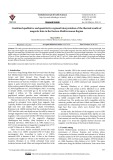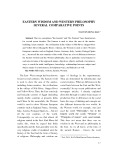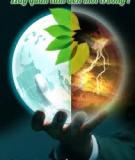
The Eastern world
-
The study presents thermal structure and active-passive tectonic parts of the Eastern Mediterranean Region. Curie point depth, heat flow map, Moho depth and sediment thickness are used for interpretation. The levelled magnetic data that obtained from the World Digital Magnetic Anomaly Map (WDMAM) is used. The magnetic anomaly is divided into 39 zones for Curie point depth estimation. The Curie point depth values are calculated into Fourier domain. Then heat flow map is generated. The estimated Curie point depth values are ranging from 4.5 km to 25 km.
 16p
16p  tanmocphong
tanmocphong
 29-01-2022
29-01-2022
 60
60
 0
0
 Download
Download
-
The two conceptions “the Eastern” and “the Western” have been known for several recent decades. The Eastern is used to show the area of the sunrise, including Asian countries - the civilizations in the valleys of Nile River, Ganges River and Yellow River (Huang He River); whereas, the Western is used to show Western European countries such as England, France, Germany, Italy, Austria, Portugal, Spain etc..., but not all the rest countries of the world.
 10p
10p  thanos1
thanos1
 17-05-2018
17-05-2018
 28
28
 1
1
 Download
Download
-
A new European civilization emerged in which monarchs competed for supremacy with the nobility and the Roman Catholic Church. The Byzantine Empire became the seat of the Eastern Orthodox Church and developed its own unique civilization.
 149p
149p  tangtuy05
tangtuy05
 01-04-2016
01-04-2016
 61
61
 8
8
 Download
Download
-
The last quarter of the twentieth century saw the dissolution of the Soviet Union, the end of the Cold War, the collapse of Communist rule in Eastern Europe, and economic unification of Western Europe. Eastern Europe nations transitioned to democracy. American popular culture had a global influence.
 126p
126p  tangtuy05
tangtuy05
 01-04-2016
01-04-2016
 66
66
 5
5
 Download
Download
-
Check out these fast facts for a snapshot of Earth's evolving climate. ∗ There is little doubt that the planet is warming. Over the last century the average temperature has climbed about 1 degree Fahrenheit (0.6 of a degree Celsius) around the world. The spring ice thaw in the Northern Hemisphere occurs 9 days earlier than it did 150 years ago, and the fall freeze now typically starts 10 days later. ∗ The multinational Arctic Climate Impact Assessment (ACIA) report recently concluded that in Alaska, western Canada, and eastern Russia, average temperatures have increased as much as 4 to 7...
 2p
2p  vantrungtran
vantrungtran
 01-02-2010
01-02-2010
 102
102
 8
8
 Download
Download
CHỦ ĐỀ BẠN MUỐN TÌM


















